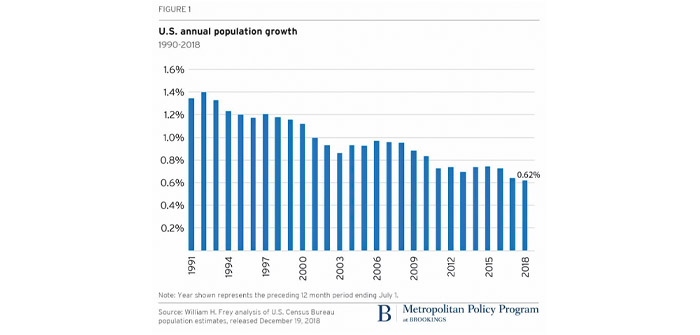The Amazing, Unimaginable Consequences of Exponential Technologies
Dark Clouds and Platinum Linings
While the world grapples with huge challenges and now commonplace political chaos and intrigue, there are massive advances occurring which will transform our world. This isn’t to minimize the impact of climate change, over-population, damage to our ecosystem, war tensions and an alarming lack of civility, but there are also major positive trends which gives us hope and a fighting chance. Peter Diamandis, a futurist many in tech follow, refers to these tech trends as “Exponential Technologies.”
The price of power, computing, data storage, internet and communication continues to drop. Even clothing is cheaper. According to U.S. Bureau of Labor Statistics, $20 in 2000 has the same “purchasing power” as $15.91 in 2018 (in the CPI category of Men’s shirts and sweaters). Automation is the major contributor to dramatic cost reductions.
We’re statistically at full-employment, with millions of jobs going unfilled. The challenge is to retrain the balance of unemployed and under-employed (have a job but not worked/paid enough) people into new, higher paying jobs.
Worldwide life expectancy continues to rise, poverty rates are at their lowest levels in recorded history, and we’re on the verge of colonizing other planets. Technology is finally enabling us to leave the planet and establish ourselves in the stars.
Amidst the daily/hourly reminders of our challenges and rapid advancements, there are some underlying, in most cases, hidden, new potentialities as well.
Linking People
7.7 billion people in the world
5.2 billion have smart phones
4.2 billion have tooth brushes
With over 1.5 billion smartphones shipping a year, 75 percent of the world’s population will own one by the end of 2019, and virtually everyone on the planet will have one by 2030 with advanced capabilities nonexistent today. Imagine the impact of everyone connected and online. Africa now has over one billion mobile phones in use, many in villages without power or running water. These users power their phones using solar power.
Yes, they can communicate via voice and video chats, but the real power at their fingertips are apps: banking and micro-lending, research and education, social networks, digital health advice, plans and instructions for building windmills and water wells, maps and routing, virtual government and citizenship, real-time news and weather.
Tapping Geniuses
One huge unintended consequence of putting a smartphone in 5.2 billion pairs of hands which is already impacting our world: tapping more geniuses. One estimate puts the number of geniuses (with IQs over 145) worldwide somewhere between 30 and 40 million. Einstein was fortunate enough to be born in Germany in 1879 and had easy access to advanced education at the University of Zurich. Now imagine if Einstein had been born in Borneo in a dirt hut, then unwind every advancement today based on his work. There are geniuses throughout the world with access unthinkable even just two decades ago. Regardless of their location of birth, a genius can now communicate and easily collaborate with others, take online courses, and with access to an incomprehensively enormous library of information on any topic. Smartphones are activating more geniuses than we can imagine, all with tremendous potential to impact the world and our future.
Bandwidth Rocks
Now consider adding another layer to the smartphone impact. Our mobile networks are upgrading to a locus of technologies referred to as 5G with data rates of up to 20 gigabytes per second and latency (i.e. delay) of one millisecond. This big leap in communication tech is creating uses of mobile technology way beyond what most people can conceive.
For example, remote surgery has been around for some time, but the low bandwidth and potentially dangerous delay in response time wasn’t safe enough for precision surgery. Now it is. With the 5G increase in bandwidth and reduction in delay, a doctor can now perform operations using robotics from an office in Bend to a remote clinic just about anywhere a 5G signal can reach, with the precision needed and virtually no delay between the doctor digitally moving a robotic “hand” to when the robot responds correspondingly. Imagine what other applications now are possible with this level of bandwidth and near-zero delay: remote drone/autonomous-vehicle operators, virtual ship captains and crew, FedEx and UPS pilots remotely flying cargo planes, or heat-resistant firefighting robots controlled by fire crews safely situated in a control center.
Out with the Old, In with the New
Another major tech trend accelerating at warp speed is the use of robotics and artificial intelligence. Unless you’ve been living under a rock, the impact of AI/robotics on jobs has been a major concern of people and governments. Depending on who you listen to, AI-controlled robotics will displace anywhere from 400 mm to 800mm jobs by 2030. What the studies don’t mention are the number of NEW jobs which will be created.
Let’s consider one of the last great disruptions during the Industrial Revolution. The horse and carriage industry lasted for 300 years. In 1900, there were roughly 8,000 cars in America and over 21,000,000 horses. By 1920, there were 8,000,000 cars and the use of horses had dropped dramatically. New York City had over 200,000 horses plodding the streets (and leaving behind their scat). One would be hard-pressed to find horses in a picture of NYC streets 20 years later. The jobs disrupted were farriers, carriage drivers, carriage builders, harness makers, hay feed producers and farmers, sanitation workers, equine breeders, etc. The jobs created were cabbies, auto factory workers, dealerships, parts manufacturers and retailers, road and highway workers, truck drivers, gas attendants, auto mechanics, body repair. The auto also gave suburban housewives the ability to commute on their own to white-collar jobs in the cities, increasing the available workforce and household incomes. Robotics will create jobs we can’t even imagine, just like autos did in 1900.
Where Is Everybody?
Thanks to a tight labor market, especially in low-paying service sector jobs, robots are stepping in where there are no humans available to fill them. For example, robotic fast-food places are popping up due to a dearth of applicants to fill low-paying jobs in the kitchen and at the counters. A recent study by the Center for an Urban Future points out the automation potential for waiters and waitresses is 77 percent and increases to 87 percent when you add in workers who prep food.
The population growth trend for Western countries such the United States is slowing dramatically while it’s increasing in third-world countries. With the current anti-immigration policies, our population is also aging out of the workforce. Millions of Baby-Boomers are set to retire. They began reaching age 65 in 2011, 26 million so far, and another 50 million will turn 65 over the next ten years. People in the U.S. age 65 and older are expected to number 78 million in 2035, while children under 18 will number 76.4 million. For the first time in history, elderly will outnumber the youth. Immigration has been a major contributor to the young-worker pipeline, contributing 35-40 percent of our younger demographic workforce. What this is pointing to is a much smaller available workforce in the future. Good news for people seeking employment, terrible news for employers.
The bottom-line: driven by a decreasing workforce, by necessity robots will fill many of these job positions.
Amazon has well over 100,000 robots in their warehouses moving racks of packages around. Yes, they displaced jobs humans could do, but they allowed Amazon to keep expanding despite the tight labor market. These robots filled jobs when humans weren’t available to fill them.
forbes.com/sites/andrewrigie/2018/09/24/the-rise-of-the-restaurant-robot/#160e8db33747
nycfuture.org/research/how-automation-will-transform-jobs-in-nyc
3D Printing Dinner and Body Parts… Seriously
These are not theoretical ideas, both are happening now. Remember Star Trek’s “Food Replicator”? Companies such as Natural Machines, ByFlow and BeeHex have created tabletop 3D Food-Printing appliances which are in use today in high-end restaurant kitchens and a few homes. As the technology improves and scales, it won’t be long until infomercials will be selling them as the next best kitchen appliance.
Today, 3D printers are creating hearts, skin, anti-bacterial teeth, bionic eyes and ears, elastic bones and ovaries. The list keeps growing and the promise it offers for humanity is breathtaking. Need a kidney replacement? Let’s grab your stem cells and print you a new one.
Imagine what else will be 3D-printed at home.
On-demand 3D-printing will change how we live in many ways and will create whole new industries, such as creating food cartridges similar to printer cartridges, new software which makes it easy to download models of food and other things to 3D-print.
techrepublic.com/article/heres-how-3d-food-printers-are-changing-the-way-we-cook/
mdlinx.com/internal-medicine/article/2668
Retraining People
The new key job skill to have: the ability to constantly learn and adapt. In a recent report by the McKinsey Global Institute, roughly one-third of all workers in the United States will have to switch occupations due to tech-driven automation by 2030. This impact is not just hitting traditional blue-collar jobs, heavy automation is also displacing jobs in finance, banking and other white-collar positions.
We need to create and support national programs to retrain displaced workers into, typically higher-paying jobs in newly-created careers. A warehouse worker transforms into robotic maintenance. A financial analyst becomes a data analyst.
Here locally, Apprenti, an intensive 22-week-long, 40-hour-per-week training program, is giving people a chance to re-architect their careers into high-paying software development positions. Oregon needs to increase funding for such programs by one-hundred-fold to avoid a humanitarian crisis and to give our citizens a fighting chance at taking advantage of the new, higher-paying jobs waiting to be filled.
Hope is Contagious
Smartphones, robotics, AI and hundreds of new exponential technologies are creating thousands of new careers and millions of new jobs, most which didn’t exist in the year 2000.
What Gene Roddenberry envisioned as Star Trek’s handheld “communicator” in its debut in “The Cage” episode in 1964 is now one of the most disruptive exponential technologies humanity has ever experienced. I would argue the discovery/use of fire was the last mega-moment. It’s hard to believe, but the iPhone didn’t exist until 2007, just 12 years ago. Earlier mobile phones were targeted at corporate users (think Blackberry and Motorola Startac). The iPhone brought amazing technology to the masses in arguably the best user experience ever designed and was adopted at the speed of light. Over two million apps have been created for these devices, with contributions from developers across the globe.
In the words of Diamandis, “The ratio of zero to one is infinite,” meaning doing something provides infinitely more returns compared to doing nothing. We have exponential technologies in our grasp to make real what we can imagine (i.e. Captain Kirk’s communicator) and move from fear and inaction to bold action.
So, the next time you read about the polar ice caps melting, imagine the potential solutions tapping 40 million geniuses will spawn and the butterfly effect of even small, purposeful actions you can take. Hope is contagious, change the world, spread the word… use your smartphone.



